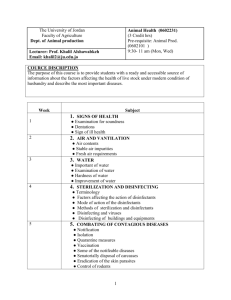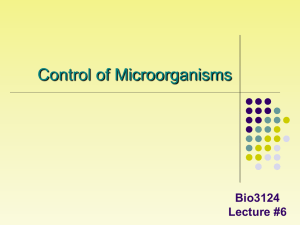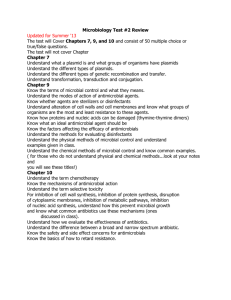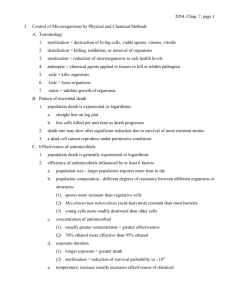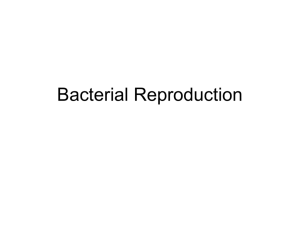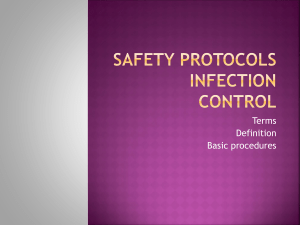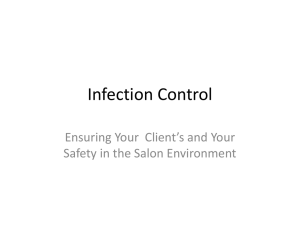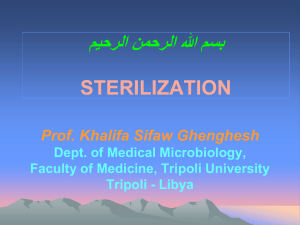Power point
advertisement
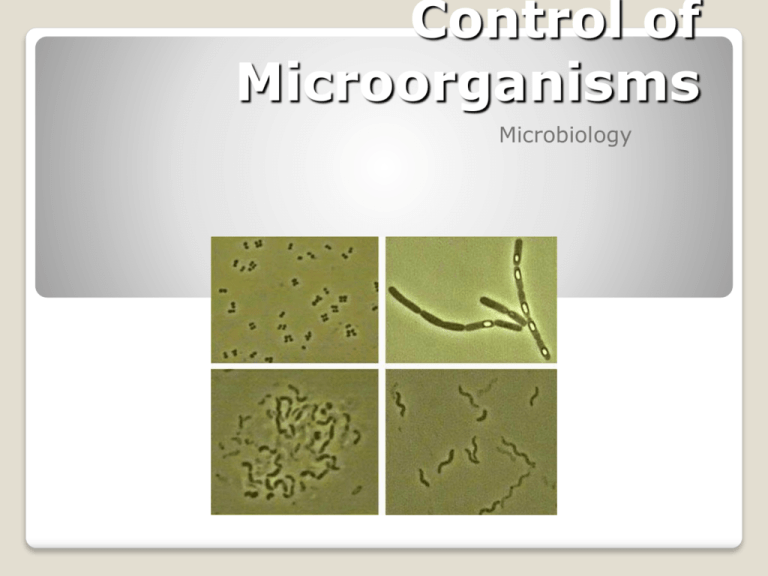
Control of Microorganisms Microbiology Effected in two basic ways: 1. Biocidal action: Killing Microorganisms 2. Biostatic action :By inhibiting the Growth of Microorganisms Usually involves the use of: 1. Physical Agents that Kill or Prevent Growth 2. Chemical Agents that Kill or Prevent Growth 3. Biological Agents: Bacteria, Fungi, Phage etc. Control of Microbial Growth Level of Resistance 1. 2. 3. 4. 5. 5. 6. 5. Endospores (Most) Parasites Mycobacteria Fungal Spores Small Non-enveloped Viruses - Polio, Rotavirus, Rabies Vegetative Fungal Cells Enveloped Viruses - Herpes, Hepatitis B & C, HIV Vegetative Bacteria (Least) Principles of Microbial Control Prevention / Control of Growth to Prevent Infection and Spoilage, Asepsis Sterilization / Complete Destruction - Real sterilization is All or Nothing) Commercial Sterilization The best we can do Reduce numbers to safe level - Utilizes a. Heat b. Radiation c. Chemicals d. Physical Removal e. Hyperbaric (High pressure) Commercial Sterilization / Heat Treatment of Canned Foods Disinfection / Reducing Growth Nonliving Surfaces Antisepsis / Reducing Growth Living Tissue Antibiotics ( “magic bullets”) Internal use Preservatives Sanitize – Subject to High Temperature (70oC) Washing (Dishwashers) or Hypo Principles of Microbial Control Cide – Suffix Meaning to Kill Stat – Suffix Meaning to Inhibit Sepsis – Bacterial Contamination Asepsis – Lack of Bacterial Contamination Principles of Microbial Control Rate of Microbial Death Bacteria Usually Die At a Constant Rate Plotted Logarithmically This Will Give a Straight Line Time to Kill in Proportion to the Population Size Large Numbers Require Greater Time Small Numbers Require Less Time Susceptibilities Vary Endospores are Difficult to Kill Organic Matter May Interfere with Heat Treatments and Chemical Control Agents Must clean first Alteration of Membrane Permeability - Susceptibility of membrane is due to its lipid and protein composition - Control Agents can alter permeability Damage to Proteins and Nucleic Acids - Break hydrogen and covalent bonds in proteins - Interfere with DNA, RNA, Protein Synthesis Control Agents Act By: Physical Methods of Microbial Control Heat Filtration Low Temperatures Desiccation Osmotic Pressure Radiation Physical Methods Most Frequent and Widely Used. Always Consider 1. Type of Heat 2. Time of Application 3. Temperature Endospores are the most heat resistant of all cells. Heat Moist Heat / Denatures Enzymes Thermal Death Point (TDP) / Lowest Temp to Kill All the Bacteria in a Broth in 10 Minutes Thermal Death Time (TDT) / Time Span Required to Kill All the Bacteria in a Broth at a Given Temperature Decimal Reduction Time (DRT) / Length of Time in Which 90% of a Bacterial Population will be Killed at a given Temperature Boiling / Kills Many Vegetative Cells and Inactivates Viruses Within 10 Minutes Moist Heat Sterilization Boiling Autoclaving Boiling • 100° C for 30 Minutes • Kills Everything Except Some Endospores • Intermittent boiling can kills spores Boil, incubate, boil, incubate, boil Does not always work Autoclaving Steam Under Pressure 121° C for 15 Minutes at 15 lb/in2 Heat-labile Substances will be Denatured Steam Must Contact the Material thermal death time (TDT) ◦ shortest time needed to kill all microorganisms in a suspension at a specific temperature and under defined conditions decimal reduction time (D or D value) ◦ time required to kill 90% of microorganisms or spores in a sample at a specific temperature Measuring heat-killing efficiency Copyright © The McGraw-Hill Companies, Inc. Permission required for reproduction or display. 18 Figure 7.1 Copyright © The McGraw-Hill Companies, Inc. Permission required for reproduction or display. 19 Other measures… Z value ◦ increase in temperature required to reduce D by 1/10 F value ◦ time in minutes at a specific temperature needed to kill a population of cells or spores Copyright © The McGraw-Hill Companies, Inc. Permission required for reproduction or display. Figure 7.2 20 Copyright © The McGraw-Hill Companies, Inc. Permission required for reproduction or display. 21 Moist heat Autoclaves – used to kill endospores efficiently – use saturated steam under pressure to reach temperatures Copyright © The McGraw-Hill above boiling Companies, Inc. Permission required for reproduction or display. 22 pasteurization ◦ controlled heating at temperatures well below boiling ◦ reduces total microbial population and thereby increases shelf life of treated material Moist heat… Copyright © The McGraw-Hill Companies, Inc. Permission required for reproduction or display. 23 flash pasteurization (high temperature short-term – HTST) ◦ 72°C for 15 seconds then rapid cooling ultrahigh-temperature (UHT) sterilization ◦ 140 to 150°C for 1 to 3 seconds Pasteurization of milk Copyright © The McGraw-Hill Companies, Inc. Permission required for reproduction or display. 24 Cook Chill F values Copyright © The McGraw-Hill Companies, Inc. Permission required for reproduction or display. 25 Cook Chill Copyright © The McGraw-Hill Companies, Inc. Permission required for reproduction or display. 26 Dry Heat Sterilization Direct Flaming Incineration Hot-Air Sterilization (Oven) Flaming the Loop Flaming the loop helps to prevent contamination of the bacteria. When flaming the loop, make sure that all of the wire has been heated to redness. Incineration • Burns and Physically Destroys Organisms • Used for a. Needles b. Inoculating Wires c. Glassware d. Body Parts? Dry Heat (Hot Air Oven) • 160° C for 2 Hours or 170° C for 1 hour • Used for a. Glassware b. Metal c. Objects That Won’t Melt Pasteurization A High Temperature Is Used For a Short Time Batch Method (LTLT) 63 °C for 30 Minutes Flash Method (HTST) 72 °C for 15 Seconds Ultra-HighTemperature is 140 °C for 3 seconds Filtration The passage of a liquid or gas through a filter with pores small enough to retain microbes. Especially important to sterilize solutions which would be denatured by heat (antibiotics, injectable drugs, amino acids, vitamins.) High-Efficiency Particulate Air Filters 1. Operating Rooms 2. Burn Units 3. Fume Hoods HEPA Filters Decreasing Temperature Decreases Chemical Activity Low Temps are Not Bactericidal Refrigeration <50 C ◦ Listeria still grows but slow ◦ Spoilage organisms still grow Freezing -180 C ◦ Spoilage due to enzymes Low Temperatures Disrupts Microbial Metabolism Stops Growth / Still Viable Freeze-drying / Dehydration ◦ Used to preserve bacteria Viruses and Endospores Can Resist Desiccation Desiccation Plasmolysis Sugar Curing / Salting May Still Get Some Mold or Yeast Growth ◦ Staphylococcus and Listeria grows in 10% salt Osmotic Pressure Radiation Acts By Destroying DNA or Damaging It. Dependent on the Wavelength, Intensity, and Duration Ionizing Radiation 1. High Degree of Penetration 2. Examples - Gamma Rays - X-rays - High Energy Electron Beams Radiation Ultraviolet Radiation 1. Nonionizing 2. Low Degree of Penetration 3. Low Penetration 4. Harmful / Skin / Eyes 5. Cell Damage / Thymine 6. Germicidal / 260 nm Kill Microbes Indirectly with Heat Microwaves Phenols and Phenolics Halogens Alcohols (70% ethanol) (iso-propanal) Heavy Metals and Their Compounds Surface-Active Agents Quaternary Ammonium Compounds Chemical Food Preservatives Aldehydes Antibiotics Chemical Control Methods Two Conditions Influence the Effectiveness of Chemical Disinfectants Type of Microbe - G+ More Susceptible to Disinfectants - Pseudomonands Can Grow in Disinfectants and Antiseptics - M. tuberculosis is Resistant to Many Disinfectants - Endospores Most Resistant Environment - Organic Matter and Increased Temp Evaluating a Disinfectant Old Standard is the Phenol Coefficient Test (FYI -- The phenol coefficient is the value obtained by dividing the highest dilution of the test solution by the highest dilution of phenol that sterilizes the given culture of bacteria under standard conditions of time and temperature.) In Lab We Use Soaked Filter Papers Antibiotic Sensitivities Types of Disinfectants Phenol and Phenolics - Another Name for Carbolic Acid / Lysol - Joseph Lister - Exert Influence By 1. Injuring Plasma membranes 2. Inactivating Enzymes 3. Denaturing Proteins - Long Lasting, Good for Blood and Body Fluids, No Effect on Spores Types of Disinfectants Halogens - Can be Used Alone or in Solution - Chlorine -- Purifies Drinking Water a. 2-4 Drops of Chlorine per Liter / 30 Min b. Forms an Acid Which is Bactericidal c. Disinfectant in Gaseous Form or in Solution as Calcium Hypochlorite - Iodine – combines with Amino Acids a. Inactivates Enzymes b. Tincture / Alcohol c. Iodophor / Organic Molecule / Betadine Alcohols - Denature Proteins - Dissolve Lipids - Tinctures - Wet Disinfectants a. Aqueous Ethanol (60% 95%) b. Isopropal Alcohol Types of Disinfectants Types of Disinfectants Heavy Metals and Their Compounds - Used for Burn Treatment - Prevents Neonatal Gonorrheal Opthalmia Silver nitrate - Denature Proteins Types of Disinfectants Surface-Active Agents - Decrease Molecular Surface Tension - Include Soaps and Detergents - Soaps Have Limited Germicidal Action but Assist in the Removal of Organisms by Scrubbing - Acid-Anionic Detergents / Dairy Types of Disinfectants Quaternary Ammonium Compounds (QUATS) - Cationic Detergents Attached to NH4+1 - Disrupt Plasma Membranes - Most Effective on Gram-Positive Bacteria - Mouthwashes and Sore Throat Remedies Chemical Food Preservatives - Sorbic Acid - Benzoic Acid InhibitFungus - Propionic Acid - Nitrate and Nitrite Salts / Meats / To Prevent Germination of Clostridium botulinum endospores Types of Disinfectants Aldehydes - Formaldehyde - Glutaraldehyde - Most Effective of all Chemical Disinfectants - Carcinogenic - Oxidize Molecules Inside Cells Types of Disinfectants Types of Disinfectants Gases ◦ ◦ ◦ ◦ ◦ ◦ ◦ ◦ Ethylene oxide Ozone Sulfur dioxide, chlorine, glutaraldehyde, methylene chloride, formaldehyde, ammonia Types of Disinfectants Antibiotics - Used to Preserve Cheese - Tomato products pH > 4.5 - Nisin Stock feeds Promote faster growth Growing Problem Indiscriminant and Inappropriate Use Super Bugs 1. Methicillin Resistant S. aureus 2. Vancomycin Resistant Enterococcus 3. Multidrug Resistant M. tuberculosis Important to test Sensitivities Antibiotic Resistance
